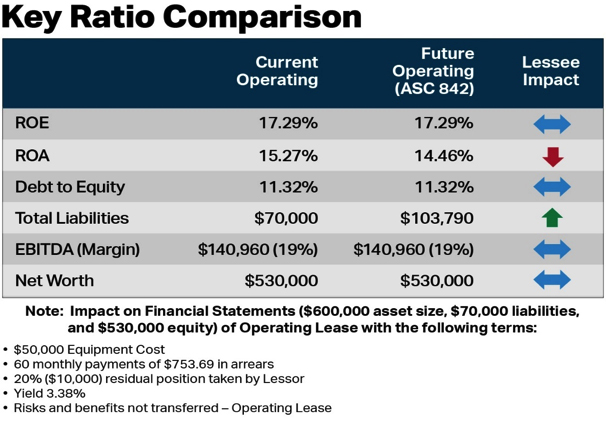By Ralph Petta, President and CEO, Equipment Leasing and Finance Association
With the approval of new rules for lease accounting by the Financial Accounting Standards Board in 2016, lessees are considering how the new standard will affect them. Many of the lease accounting changes are relatively neutral and should not impact the ability of companies to acquire productive equipment to operate and grow their businesses. The primary reasons to lease equipment will remain intact under the new standard, which is known as Accounting Standards Codification Topic 842 (ASC 842) and will generally take effect in 2019. One of the key changes is that leases previously classified as operating leases under current accounting standards will now be capitalized and thus reported on corporate balance sheets. With the changes in balance sheet reporting, some financial statement ratios may be affected.
A financial statement and its corresponding ratios are a key indicator of a company’s financial health and are relied on by lenders and reviewed by potential investors, so it is important to understand any changes to financial statement ratios under the new standard.
Under ASC 842, operating leases will no longer appear simply as a table of future payments in the footnotes; they will appear as a “right-of-use” asset and an offsetting lease liability on the balance sheet. We understand from credit agencies that the lease liability should be considered a non-debt type of liability; that is, an “other” operating liability. As a result, the return on assets (ROA) financial ratio is likely the only ratio that will change, although total liabilities will increase. Other financial ratios should remain unchanged. It is expected that there should be minimal impact on debt covenants and no impact on debt limit covenants. Overall, the new rules should have no impact on the profit and loss (P&L), or income statement because the lease-related costs should remain the same.
To illustrate the changes in the key financial ratios, let’s examine the difference between leasing a $50,000 piece of equipment under the current standard, ASC 840 (formerly known as FAS 13), and the new standard, ASC 842. Looking at the methods for calculating typical financial ratios, you can see that some ratios are unchanged (blue sideways arrows), while some decline (red downward arrow) and some increase (green upward arrow).

There are many reasons to lease equipment—managing cash flow, preserving capital and available traditional lines of credit, obtaining flexible financing solutions, managing tax liabilities and avoiding equipment technological obsolescence, just to name a few—that businesses will continue to enjoy with reporting leases on balance sheet. For more information and resources on ASC 842, including FAQs, 8 Steps to Help Transition and infographics, visit http://EquipmentFinanceAdvantage.org/newLAR.cfm.
Disclaimer: The information in this document is a summary only and does not constitute financial advice. Readers should obtain their own independent accounting advice that takes into account all relevant aspects of a particular lessor’s or lessee’s business and products.
 About the Author
About the Author
Ralph Petta is the President and CEO of the Equipment Leasing and Finance Association (ELFA), the trade association that represents companies in the $1 trillion equipment finance sector, which includes financial services companies and manufacturers engaged in financing capital goods. ELFA has been equipping business for success for more than 50 years. For more information on equipment financing, please visit www.EquipmentFinanceAdvantage.org and follow ELFA on Twitter @ELFAonline.
©Equipment Leasing and Finance Association 2017. Reprinted with permission.
In this episode, I sat down with Beejan Giga, Director | Partner and Caleb Emerson, Senior Results Manager at Carpedia International. We discussed the insights behind their recent Industry Today article, “Thinking Three Moves Ahead” and together we explored how manufacturers can plan more strategically, align with their suppliers, and build the operational discipline needed to support intentional, sustainable growth. It was a conversation packed with practical perspectives on navigating a fast-changing industry landscape.